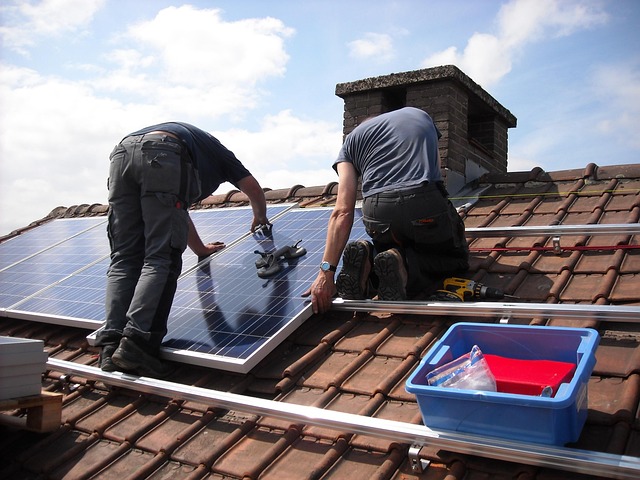When considering a roof replacement, understanding residential roofing options is key. From cost-effective asphalt shingles to durable metal roofs, each material has unique benefits and drawbacks. Roof style (flat, pitched, or gable) also impacts aesthetics and structural integrity. Consulting professionals helps tailor solutions for climate, local codes, and individual needs, ensuring safety and appeal. Homeowners should replace roofs when damaged or aged (20-30 years), addressing leaks, missing shingles, or weather damage promptly. The process involves expert assessment, cost estimates, preparation (scaffolding, roof deck setup), and final application of new roofing material for optimal protection. Choosing suitable materials based on climate and budget is crucial; common options include asphalt, metal, tiles, or premium alternatives. Avoiding mistakes like unsuitable materials or poor preparation leads to long-term problems. Regular maintenance, including inspections, gutter cleaning, sealing, and high-quality materials, ensures roof longevity and optimal performance.
Considering a roof replacement? Navigating residential roofing options can be daunting, but understanding when and how to replace your roof is crucial for your home’s protection. This comprehensive guide breaks down every step of the process, from assessing your current roofing material to choosing the best fit and avoiding common mistakes. Learn about maintaining your new roof for longevity and make informed decisions regarding your residential roofing.
Understanding Your Residential Roofing Options

When considering a roof replacement, understanding your residential roofing options is key. There are several types of materials available in the market today, each with its unique advantages and disadvantages. Asphalt shingles remain a popular choice for their affordability, ease of installation, and wide availability. Metal roofs, on the other hand, offer superior durability, longevity, and energy efficiency, making them a smart investment for many homeowners.
Beyond material types, you’ll also encounter different roofing styles like flat, pitched, or gable roofs. Each style has its own aesthetic appeal and functional considerations, influencing both your home’s exterior look and overall structural integrity. Consulting with a professional roofer can help guide your decision based on your climate, local building codes, and specific needs, ensuring a safe and visually appealing residential roofing solution.
When to Consider Roof Replacement

Many homeowners often wonder when it’s time to consider roof replacement for their residential roofing. While a roof is one of the most essential components of your home, protecting it from the elements, its longevity varies depending on several factors. Generally, if you notice signs of damage or significant age, it might be time for a new roof. Aged shingles are more prone to tearing, curling, and cracking, increasing the risk of water intrusion and further structural damage.
Residential roofing systems typically last between 20 to 30 years with proper maintenance. However, factors like extreme weather conditions, poor installation, or subpar materials can significantly reduce this lifespan. If your roof is showing signs of deterioration, such as leaks, missing shingles, or visible damage from hail or wind, replacing it becomes crucial to prevent further complications and ensure the safety and integrity of your home.
The Steps Involved in a Roof Replacement Project

A roof replacement project is a significant undertaking for any homeowner, but understanding the steps involved can help make the process smoother. It begins with an expert assessment to determine the extent of repair or replacement needed. This includes inspecting the existing roofing material, identifying damage, and evaluating the overall structural integrity of the roof. Once the assessment is complete, homeowners should receive a detailed estimate outlining the cost, materials, and timeline for the project.
The next phase involves preparation, which may include setting up scaffolding, protecting nearby areas from debris, and arranging for temporary shelter if necessary. The old roofing material is then removed, layer by layer, ensuring proper disposal or recycling. After the removal, the new roof deck is installed, providing a solid foundation for the new roofing system. This is followed by the installation of new underlayment, flashing, and vents, which are crucial components for water protection and ventilation. Finally, the new roofing material—whether shingles, tiles, or metal—is carefully applied, ensuring proper sealing and alignment.
Choosing the Right Roofing Material for Your Home

When considering a roof replacement, selecting the right roofing material is paramount for any homeowner. The choice extends beyond aesthetics; it should align with your climate, budget, and long-term goals. For example, in snowy regions, a roof with excellent insulation properties can significantly reduce energy costs during winter. Conversely, in areas prone to intense sunlight, reflective or darker materials can help keep the home cool, mitigating the need for excessive air conditioning.
Residential roofing options are diverse, from traditional asphalt shingles known for their affordability and ease of installation, to more premium alternatives like metal, tile, or wood. Each has unique benefits and drawbacks. Metal roofs, for instance, offer exceptional durability and resistance to extreme weather but can be costlier. On the other hand, tiles provide a beautiful, classic look but may require specialized skills for installation and are heavier than most materials. Understanding these nuances ensures you make an informed decision tailored to your specific residential roofing needs.
Common Mistakes to Avoid During Roof Replacement

When undertaking a roof replacement, homeowners often make mistakes that can lead to long-term issues and additional costs. One of the most common errors is selecting an unsuitable roofing material for their region’s climate. For example, using lightweight materials in areas with heavy snowfall or dense, water-resistant options in places prone to high humidity can result in structural problems and leaks. It’s crucial to consult with professionals who understand local weather patterns and building codes to ensure the chosen residential roofing is both practical and durable.
Another frequent mistake is neglecting proper preparation before the replacement process begins. This includes failing to secure necessary permits, inadequate removal of the old roof, or not setting up protective barriers to contain debris. These oversights can cause delays, increase costs due to additional labor, and potentially lead to safety hazards for both residents and workers. Proper planning and coordination are essential to a smooth roof replacement process and ensuring the new roofing provides long-lasting protection for the home.
Maintaining Your New Roof for Longevity

After installing a new roof, homeowners should focus on maintaining it to ensure longevity and optimal performance. Regular inspections are key; checking for loose or damaged shingles, flashing, and gutters can prevent small issues from becoming big problems. Cleaning your gutters is also essential as buildup can weigh down the roof and cause water damage.
Additionally, keeping your roof free from debris and regularly sealing any cracks or openings can help maintain its integrity. Using high-quality materials during installation and following manufacturer recommendations for maintenance will contribute to a longer-lasting residential roofing system, saving you time and money in the long run.
